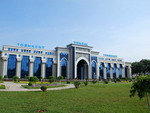Up to date, Tashkent acts as a main junction, connecting all railway services of Central Asia. This is exactly why “Tashkent” Central Railway Station («Northern Railway Station»), one of the main city’s road junctions plays such important role in the metropolitan life. “Tashkent” Station is located in Kichik Khalka Yuli Street, to south-east from the city’s center and just 5 km from it. The station is a departure point for trains both by international direction to the CIS countries, and by local and regional directions, including such cities as: Bukhara, Khiva, Samarkand, Termez, Urgench. Suburb rail runs are performed from Southern Railway Station, located not far from Tashkent airport.
Near “Tashkent” Station there is “Tashkent” underground station, the Grand Mir Hotel and also the Mirabad Bazaar and Holy Assumption Orthodox Cathedral Church. Besides, as soon as the metropolitan guests get off the train, they can start sightseeing from one of best-known landmarks, so-called the “Museum of Steam Locomotives” located in the open air. It has built up a unique collection of various railroad engineering models from the beginning of the XX century.
When in the second half of the XIX century Tashkent became a part of the Turkestan Governorate General and a new part of the city, inhabited by the settlers from Russia, was built there appeared a need in construction of a railroad. Its purpose was not only to connect Tashkent with Russian central provinces, but also simplify considerably the conditions for selling and exchanging of goods between Russia and Turkestan. The final decision on construction of the Central Asian railroad facilities was made by an ad hoc commission in year 1847. As it was expected, the construction of first railway lines caused a rise in trade turnover, as well as price cutting for articles of prime necessity. Furthermore construction of the railroad dramatically boosted the development of the country itself, including industrial one.
In spite of the fact that the commission prioritized the construction of the railroad connecting Tashkent and Orenburg, it was not the first line which was opened and used. In 1885, under the command of the general M. Annenkov, a building project was launched, which provided for construction of another road - Transcaspian Military Road on route Tashkent-Krasnovodsk. The official operation of this line started from 1 May 1899. The Transcaspian Military Road Administration was located in Ashkhabad city. As far as the Tashkent-Orenburg road concerns, its official commissioning took place not until 1 January 1906; its administration was established directly in Orenburg. Construction of this line became a landmark event - a gate from Central Asia to Central Russia was finally opened.
Where there is a railway, there is a station. The Tashkent Railway Station building project was undertaken by the civil engineer G. Swarichevsky. Its construction was completed in 1899, but after the dramatic earthquake of 1902, the building had to be reconstructed. The repair work was finished in 1905 with a pleasant novelty – the first town clock was installed over its main entrance. After that the Tashkent Railway Station building was subject to several insignificant reconstructions, including those under the E. Limar’s project of 1935-1947. Finally in year 1957, the station building was completely reconstructed, whereby its architectural look was completely changed: the building structure made of concrete and glass acquired a modern appearance. The project was developed by V. Biryukov, L. Travyanko and V. Rusanova. It is not surprising that that later on, the whole landside region was used for needs of the station and directly of the railroad (now this territory belongs to Mirabad district of Tashkent city).
Tashkent HOTELS
Tashkent Guide
ADVANTOUR CONTACTS
- Contact Us
- Tel: +998 78 150 3020
- Fax: +998 78 150 3021


